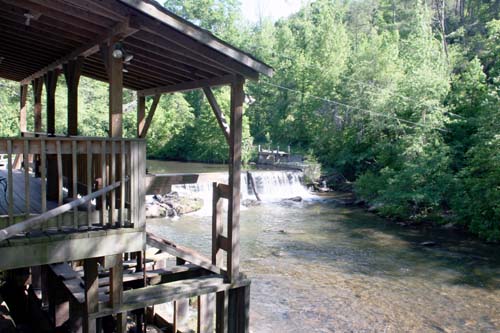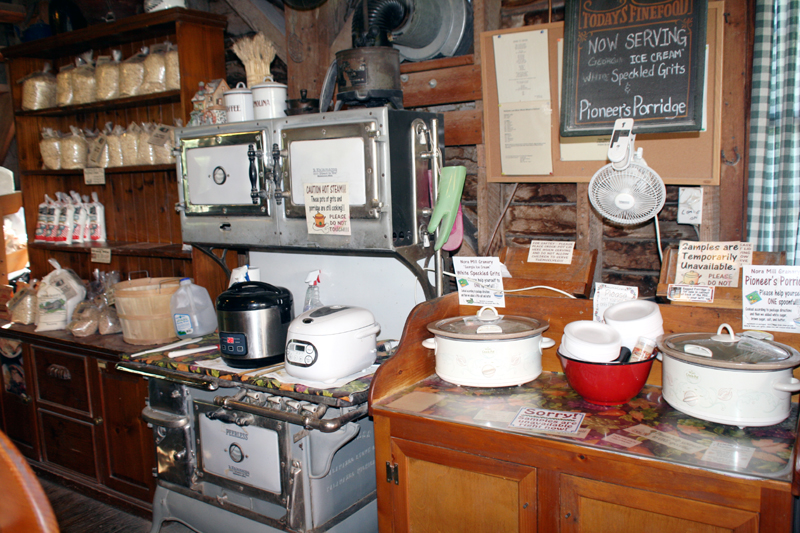|

 |
Tommy Martin turns the switch
that controls the turbines
|
Article and photos by Kathleen Walls
Many places in the Mountains of Appalachia have their own
special magic. A visit there is like stepping back to a more
peaceful time. Most places you visit and leave all their magic, except
the memories and maybe a few pictures, behind when you return to
the modern world.
Nora Mill on the outskirts of Helen,
Georgia in the Sautee-Nacoochee Valley is one of those enchanted
places where you can retain a bit of their special magic after
the visit. In fact, every time you cook up
a pot of their "Dixie Ice Cream" more prosaically known
as grits, you are enjoying something that flowed directly from
the heart of the mill.
Packaged in simple cloth bags, grits from Nora Mill is not a
product of our fast-paced mechanized world. It was created in
the ways of a much simpler time.
The story began when Daniel
Brown build the original building in
1824. John
Martin bought it in 1876. He was a gold miner who had struck it
rich in Georgia's gold rush and wanted to build his empire with
a mill in Sautee-Nacoochee Valley. He decided on water turbines
from Rome, Georgia instead of a paddlewheel. He bought the best
granite burr stones he could get from Marne Valley in
northern France. 137 later they are still working fine.
 |
| Dam behind the mill on the
Chattahoochee River |
In 1902 Lamartine G. Hardman, Later governor of Georgia, bought
the mill and named it Nora Mill for his little sister who had
passed away.
Retired Army Lieutenant Colonel Ron Fain purchased the mill in
1981. The mill is still owed by the third generation of the Fain
family who are active in the operation.
Tommy Martin, the present miller, can explains the workings of
the mill so well you will feel transported back in time. He will
bring you out back to the Chattahoochee River and show you the
power source.
 |
| Milled grain falls throught the
chute into collection bin |
The
dam was built in 1824 and as such it grandfathered in and they
can rebuild without any permits. The newest was built in 1996.
That mill pond powers the turbines. The water runs down the 100
foot millrace The maintenance is non-ending. There is a shaft
running under the building.
"This was 'going green' before
'going green' was cool," Tommy said.
Water turbines were a very important part of history. This was
the same technology used in hydraulic dams. It was much more
effective than the paddlewheel. Turbines allowed control from
within whereas the old paddlewheels were at the mercy of the
water speed and current.
 |
| Tommy Martin showing some of the mill machinery |
Tommy demonstrated how the span style="mso-spacerun: yes"> kernels
of corn are hand poured into the mill. Wheels, gears and pulleys
turn the main drive belt and eventually turns one of the 1,500
pound stne stone. He explained "There is a bedstone and
runnerstone.
The
bedstone never moves. The runnerstone turns and crushes the
kernels. There are grooves in the stones that do the actual
grinding. When it turn it pushes the grain out of the grooves.
You position the stones closer for fine ground and farther for
coarser. The stones
themselves should never touch."
An
old saying that you probably heard as a child grew out of
milling. "You never want to smell the grindstone. If
yyou do it means you are wearing your groves down," Tommy
explained "That is why I keep my nose to the grindstone"
Nora Mill
is your chance to watch (and purchase) corn ground as it was a
century ago, either grits or corn meal. Prior to opening his
mill, John Martin traveled
to New York. Visiting a restaurant, he ordered
grits, a southern staple
then as well as today. The waiter laughed at him and said, "We
don't sell Dixie Ice Cream here."
----------So when he opened Nora Mill in Sautee-Nacoochee Valley, he decided to call his grits
Dixie Ice Cream. It retains that name to this day at Nora Mill.
"The difference between the product made with the old stone
mills and the new high powered mills of today is that the new
machines are running so fast and so hot it would cook the germ
of the corn. That would gum up the machinery. So they take it
out rremoving 97% of
the nutrition and vitamins. Then they put a little bit of the
nutrition back in and call it 'enriched.'"
 |
| Kitchen in "Nora Mill Next Door" |
At Nora Mill you get the
real thing. You can taste the difference. And you can feel a
little bit of the magic in every bite. It's one visit where you
can bring a little bit home and enjoy it later. o:p>
After you tour the mill, step over next door and visit their
old-fashioned country store and
gift shop called
"Nora Mill Next Door,"
filled with lots of items you will want to take away with you.
It even has a large kitchen where someone will be cooking up
some samples of the mill
products. It was delicious corn bread the day we viited.
A visit to Nora Mill is a form of
time travel. I warn you however, store bought grits will
never taste the same again. And if you think you don't like
grits, give the "Dixie Ice Cream" from Nora Mill a try.
cook it up using a little cream and butter in the water. It's
True Grits.
For more info:
http://www.noramill.com
|